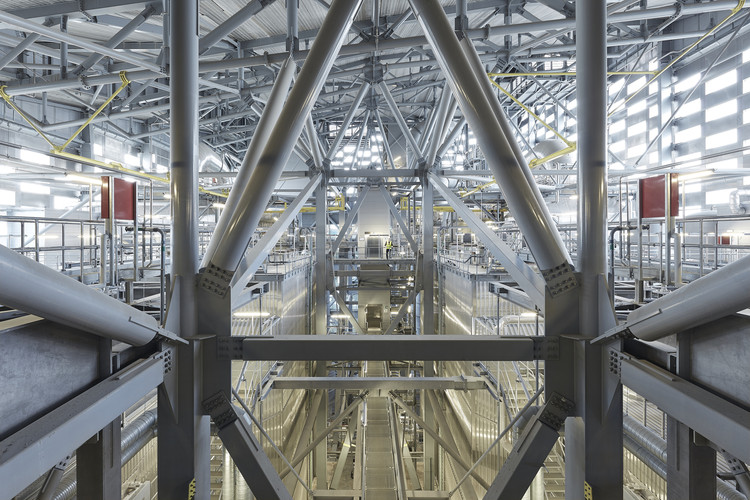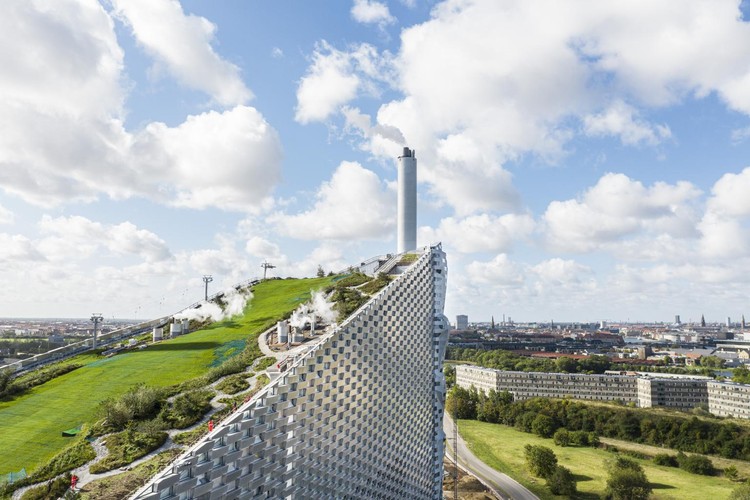
Nearly a decade in the making, the landmark CopenHill waste-to-energy plant first imagined by Bjarke Ingels Group has finally opened in Copenhagen. ArchDaily initially covered BIG's project in January 2011, and the waste-to-energy plant would later include hedonistic ideas of the world’s first steam ring generator and crowdfunding through Kickstarter. Today, the project has fulfilled many of its promises, and CopenHill stands as a modern architectural zeitgeist reflecting BIG's own evolution.

The idea that would become CopenHill actually dates back to 2002, before BIG, when Bjarke Ingels’ firm went by the name of PLOT. What they proposed was to insert a public urban space in the densest area of Copenhagen, where land is most limited, by placing a ski-slope topography above the largest department store in the city. The idea didn't come to fruition, despite winning the competition, but it was the first seed of the idea for the CopenHill we see today. Fast forward almost a decade, and it was announced in 2011 that BIG had won the international design competition for Copenhagen's waste-to-energy plant with AKT, Topotek 1, Man Made Land, and Realities:United.

CopenHill has had a variety of names since 2011, from Amagerforbrændingen to Amager Bakke and CopenHill. Located in an industrial area near the city center, the new waste-to-energy plant aspired to become an exemplary model in the field of waste management and energy production, as well as an architectural landmark. At the time, the project was the single largest environmental initiative in Denmark with a budget of 3,5 Billion DKK. It was set to replace the adjacent Amagerfor-braending plant, integrating the latest technologies in waste treatment and environmental performance.

As BIG said back in 2011, "The main function of the façade is to hide the fact that factories are having a serious image/branding problem. We want to do more than just create a beautiful skin around the factory. We want to add functionality! The ambition of creating added value in terms of added functionality does not stand in contrast to the ambition to create beauty. It does not have to be either/or – it can be both!" They also announced the proposal to turn the roof of the new Amagerforbraending into an artificial ski slope for the citizens of Copenhagen and its neighboring municipalities.
Fast forward a few years, and the plant breaks ground as a series of superlatives. It sets out to become the cleanest waste-to-energy plant in the world, to be the tallest and biggest building in Copenhagen, to house Denmark’s first ski-slope, and to emit its CO2 emissions in sudden, bursting smoke rings. ArchDaily's Managing Editor Vanessa Quirk wrote that it was "a signal that BIG has finally reached maturity, truly coming into its own as a firm." She emphasized how BIG aimed to connect to people. "This is the key: BIG has learned to use its outlandish ingenuity for more that its own sake; it has learned to use its guerilla-like tactics to encourage public participation and then give that participation purpose. Amager Bakke is pure BIG, but a more grown-up, bigger BIG."
In 2015 we saw efforts to bring the world’s first steam ring generator to life. But, BIG hit a road block: as Bjarke Ingels explained to FastCo Design, "there were no smoke ring-emitting manufacturers in the yellow pages." In order to give locals a new understanding of the issue of global warming, for every ton of CO2 generated by the burning of waste, the plant would emit a super-sized ring of steam into the sky from the chimney perched at the top of its sloping roof. Sadly, the idea was not realized, and the Kickstarter campaign lost steam.

Last year, SLA revealed the signature park and ski slope design that caps CopenHill. Initially master planned by BIG, the 170,000-square-foot (16,000-square-meter) design seeks to reclaim a typically unused element of a building for the public through the introduction of nature-filled program. During summer months, the rooftop activity park will provide visitors with hiking trails, playgrounds, fitness structures, trail running, climbing walls, and views across the city. In the winter, the park will be joined by a over 1,640 feet (500 meters) of ski slopes.
Today, CopenHill is the result of nearly ten years of thought, time and design. To complete the project, BIG worked with SLA, AKT, Lüchinger+Meyer, MOE and Rambøll. The plant aspires to embody the notion of Hedonistic Sustainability while aligning with Copenhagen’s goal of becoming the world’s first carbon-neutral city by 2025. The 41,000m2 project includes an urban recreation center and environmental education hub, turning social infrastructure into an architectural landmark. Beneath the slopes, furnaces, steam, and turbines convert 440,000 tons of waste annually into enough clean energy to deliver electricity and district heating for 150,000 homes. CopenHill features a continuous façade comprised of 1.2m tall and 3.3m wide aluminum bricks stacked like gigantic bricks overlapping each other.


“CopenHill is a blatant architectural expression of something that would otherwise have remained invisible: that it is the cleanest waste-to-energy power plant in the world. As a power plant, CopenHill is so clean that we have been able to turn its building mass into the bedrock of the social life of the city – its façade is climbable, its roof is hikeable and its slopes are skiable. A crystal clear example of Hedonistic Sustainability – that a sustainable city is not only better for the environment – it is also more enjoyable for the lives of its citizens.” Bjarke Ingels, Founder & Creative Director, BIG.
Bjarke goes on to explain that CopenHill means today. “To me, CopenHill is a perfect example of the world changing power of architecture. That we have the power to give form to the future that we want to live in. My son turns one next month – he won’t ever remember that there was a time when you couldn’t ski on the roof of the power plant – or climb its facades. He will take that for granted – and so will his entire generation. Clean energy and skiable power plants is going be the baseline of their imagination –the platform from which they will leap and propose new and wild ideas for their future. Standing at the peak of this humanmade mountain that we have spent the last decade creating – makes me curious and excited to see what ideas this summit may spark in the minds of future generations.”


CopenHill stands as a monument to BIG's trajectory and echoes the practice's influence on architecture and design. For a generation of architects, the project remained a possibility, living in the realm of ideas. As it broke ground and began to rise, so too has the profession changed. We have become more attuned to the climate crisis and the relationship between building and environmental impact. At the same time, we increasingly embrace new building programs and community engagement. CopenHill has become more than the sum of its parts, and more than a collection of superlatives. It symbolizes a desire to reimagine the built environment for future generations, and in turn, bring joy back into our cities.















